Pickles are a delicious and versatile condiment that can add a tangy, crunchy element to any meal. While the traditional method of pickling involves canning and fermentation, quick pickling offers a faster and easier way to enjoy homemade pickles. This guide will delve into the world of quick pickling, providing you with all the information you need to create your own delicious pickles at home.
What is Quick Pickling?
Quick pickling is a method of preserving vegetables in a vinegar solution for a shorter period of time compared to traditional fermentation. This results in pickles that are ready to eat within a few days or weeks, as opposed to months or years for fermented pickles. Quick pickling is a great option for those who want to enjoy fresh, flavorful pickles without the commitment of long-term preservation.
The Basic Ratio for Quick Pickles
The foundation of quick pickling lies in the ratio of vinegar to water. The most common ratio is a 1:1 mixture of vinegar and water. This creates a balanced brine that effectively preserves the vegetables while imparting a pleasant tangy flavor.
Additional Ingredients
While the basic ratio forms the core of the pickling brine, you can customize the flavor profile by adding various spices, herbs, and aromatics. Common additions include:
- Spices: Black peppercorns, coriander seeds, mustard seeds, bay leaves, allspice, cloves, red pepper flakes, marash chili flakes, star anise, caraway seeds, fennel seeds
- Fresh Herbs: Dill, mint, tarragon, cilantro
- Other Fresh Aromatics: Ginger, garlic, chili peppers (serrano, jalapeno, fresno), fennel fronds, citrus peel (lemon, lime, orange)
Choosing the Right Vinegar
The type of vinegar you choose will significantly impact the flavor of your pickles. For a milder, more nuanced flavor, opt for champagne vinegar, white wine vinegar, or rice vinegar. For a bolder, more robust flavor, consider using red wine vinegar or apple cider vinegar.
Preparing the Vegetables
The ideal vegetables for quick pickling are those that are pleasant to eat raw and have a crunchy texture. Some popular choices include:
- Veggies: Carrots, fennel, cucumbers, kohlrabi, green beans, cauliflower, sweet or hot peppers, zucchini, red onions, shallots, radishes, celery, cabbage, ramps
- Fruits: Apples, pears, fuyu persimmons, stone fruits (peaches, plums, nectarines, cherries), pineapples
The Pickling Process
- Prepare the vegetables: Wash and dry the vegetables thoroughly. Slice or chop them into desired shapes and sizes.
- Combine the brine: In a non-reactive saucepan, mix the vinegar, water, salt, and sugar according to the chosen ratio. Heat the mixture gently until the sugar and salt dissolve.
- Pack the vegetables: Place the prepared vegetables and desired spices, herbs, or aromatics in a clean, airtight container.
- Pour the brine: Pour the warm brine over the vegetables, ensuring they are completely submerged.
- Refrigerate: Seal the container and store it in the refrigerator for at least 24 hours, or up to 3 weeks.
Tips for Perfect Pickles
- Use a kitchen scale to ensure accurate measurements for the brine ratio.
- Slice the vegetables thinly for faster pickling.
- For tougher vegetables, blanch them briefly in boiling water before pickling.
- Pickle different types of fruits and vegetables separately to ensure even pickling.
- Use non-reactive containers for pickling.
- Store leftover brine in the refrigerator for future use.
Flavor Combinations for Inspiration
- Pickled jalapeno peppers: Crushed garlic, cilantro sprigs, lime peel, cumin seeds
- Pickled onions: Crushed ginger, halved jalapeno
- Pickled carrots: Fresh dill, mustard seeds, peppercorns
- Pickled apples: Apple cider vinegar, fennel fronds, coriander seeds
- Pickled fennel: Champagne vinegar, fresh dill, garlic, fresno chili
Using Your Pickles
Quick pickles are incredibly versatile and can be enjoyed in various ways:
- As a condiment: Top tacos, salads, sandwiches, and burgers with your favorite pickles.
- In salads: Add a tangy crunch to salads with thinly sliced pickles.
- As a garnish: Elevate cocktails and Bloody Marys with pickled onions or peppers.
- In dips and sauces: Add a burst of flavor to dips and sauces with chopped pickles.
Quick pickling is a simple and rewarding way to create delicious homemade pickles. By following the basic ratio, experimenting with different flavors, and using the tips provided, you can enjoy fresh, flavorful pickles in no time. So, grab your favorite vegetables, gather your spices, and get pickling!
What Is Pickle Brine?
To put it simply, pickle brine is the mixture used to aid in the pickling (and eventually preservation) of fruits and vegetables. Yes, all types of fruits and vegetables!.
The ingredients for this pickling liquid are water, vinegar, sugar, and salt. There are some additional flavoring and functional ingredients. Nonetheless, these four are necessary in a simple pickle brine recipe.
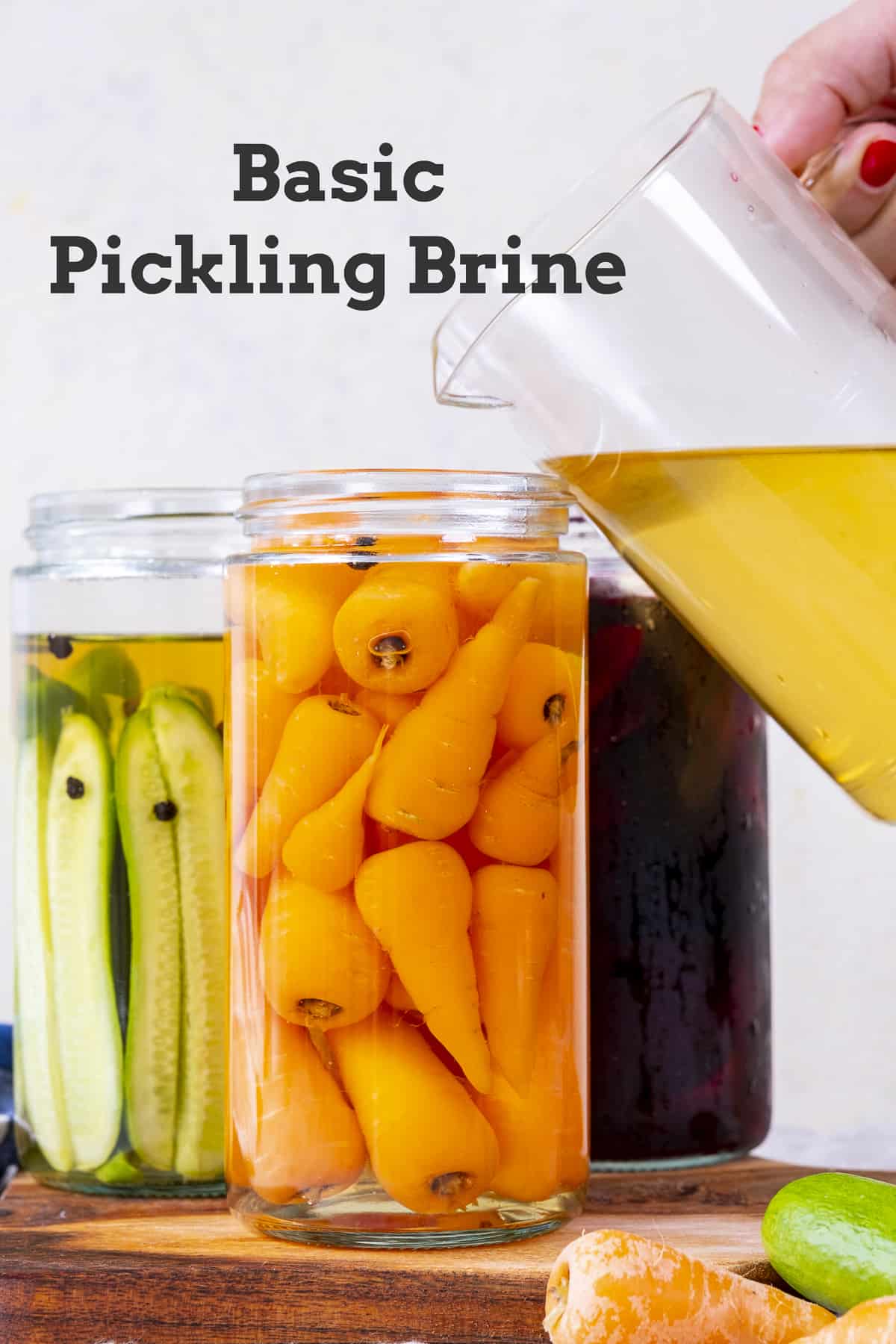
They contribute to the creation of a liquid that prolongs the shelf life of fresh fruits and vegetables. It creates an environment that is unlivable for mold. Additionally, they acquire a super-crisp texture and flavor at the same time.
Making your own pickle brine is so simple that you won’t really need to buy it from the store. Lets see what we need.
Water, vinegar, salt, and sugar are the four basic ingredients of any classic pickle brine recipe.
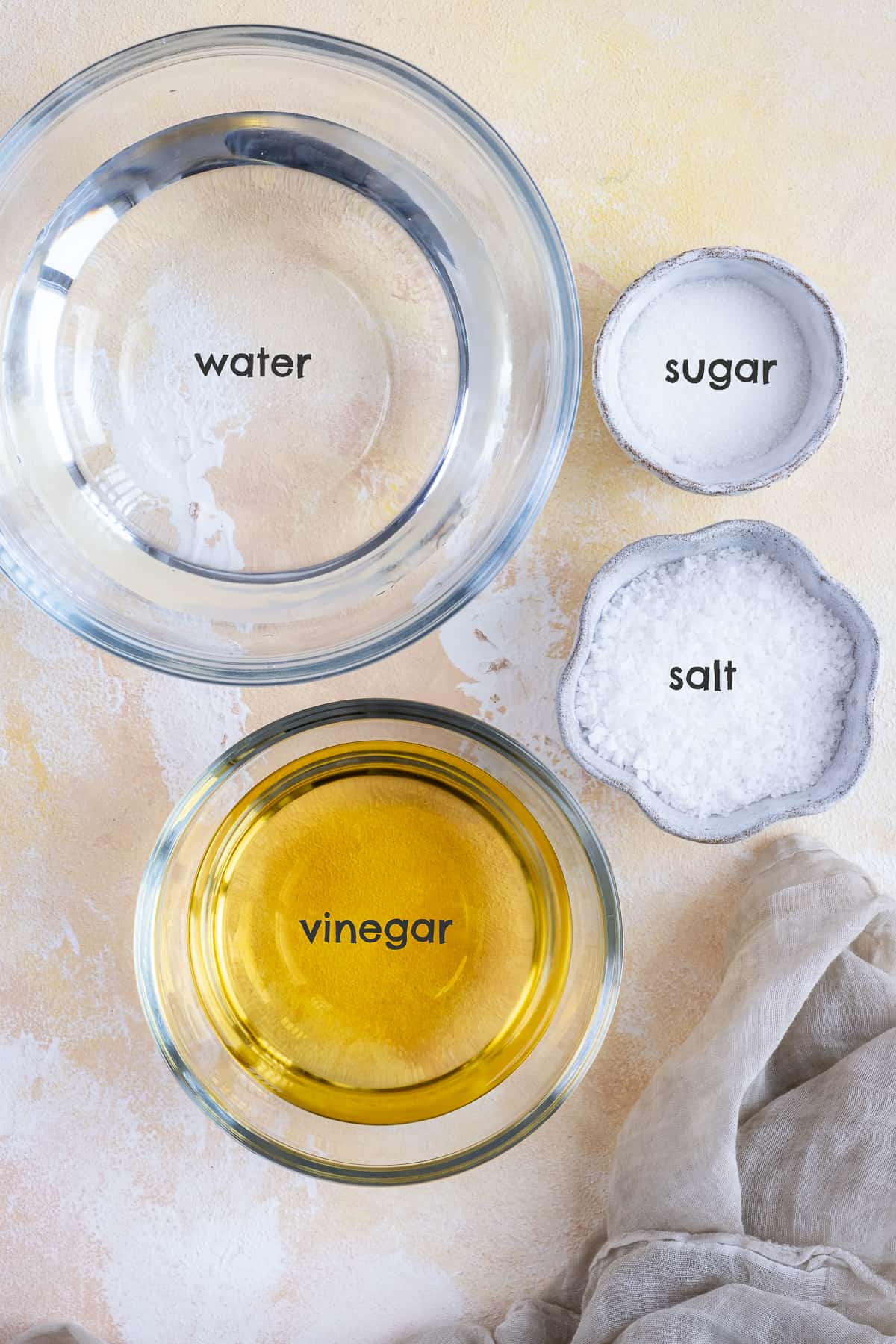
Water is added to pickling brine in order to achieve the ideal ratio of 2050 percent water to 2050 percent vinegar. It assists in achieving the ideal balance of acidity to function as a pickle (and inhibit bacterial growth) without overpowering flavor.
The remaining ingredients are more functional.
Vinegar: For this recipe, regular apple cider vinegar with a 5% acidity level is used. However, you can use any vinegar in its place, excluding malt or balsamic vinegar. Rice vinegar, white wine vinegar, and distilled white vinegar all function well. Just be aware that the pickling vegetables will absorb the flavor of the vinegar.
Use the same amount of lemon juice if you dislike the taste or smell of vinegar. Add a small amount of citric acid as well if you are unsure of the lemons’ acidity.
Salt: Use kosher salt, sea salt or pickling salt. Avoid using table salt for a brine because it contains additives, iodine, and anti-caking agents that could affect the quality of the pickles you make.
Sugar: This is not a sweet pickle brine recipe. It is more on the tangy side. The pickles and tangy brine are slightly sweetened by a small amount of sugar in our recipe. Of course, if you don’t want any sweetness, you can omit it entirely.
The flavor of your brine can be drastically altered by a plethora of easy additions. When the brine liquid is heating up, they can be added to the jars containing the vegetables directly. Either way, you will add their flavor.
Whole spices like mustard, coriander, celery, and dill seeds, as well as black peppercorns, allspice berries, and cinnamon sticks, are some of the best pickling spices to use. Additionally, adding spices like turmeric, bay leaf, and red pepper flakes would be fantastic. Additionally, you can add some fresh or dried chili peppers to it if you want it spicy. To further simplify your life, pre-made pickling spice blends are available at stores.
Herbs are great additions too. Our favorites are fresh dill, parsley, rosemary, thyme or oregano. We dont recommend boiling them with the brine liquid. After adding the vegetables and desired herbs to the jars, cover them with the brine.
You can also add aromatics to the jars, such as garlic, shallots, ginger, and green onions, also known as scallions, for even more flavor.
Let’s now see how to create a simple pickle brine from scratch. You only need a couple of ingredients to start with. However, you are free to experiment as much as you like with the herbs and spices in our recipe!
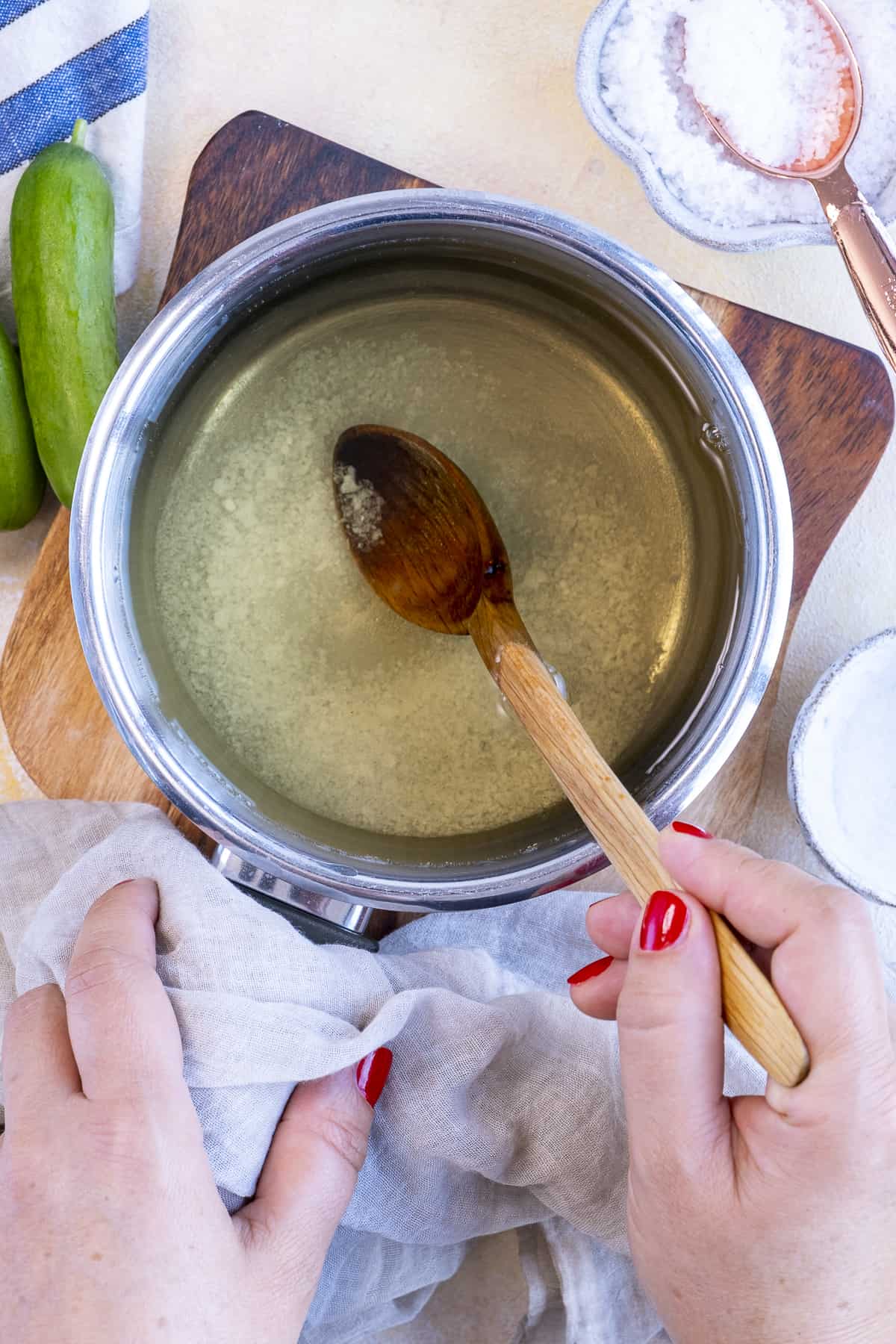
First, bring two cups of water, two cups of vinegar, one tablespoon of sugar, and three tablespoons of kosher salt to a boil in a medium saucepan. At this point, add any spices you wish to use in your brine, such as dill, coriander, or mustard seeds, to the saucepan. Then bring it to a boil over medium-high heat. Before continuing, make sure that the salt and sugar have completely dissolved.
Reduce the heat and let the saucepan sit for about ten minutes to allow the liquid to cool slightly. Pickle veggies like carrots, onions, cucumbers, radishes, green tomatoes, or zucchini right away by using it. We also love pickling beets with this brine.
If you aren’t going to use your pickle brine right away, allow it to cool fully before storing it in the refrigerator in jars or other lidded containers for later use. It keeps well for up to 2 months.
If you are going to make refrigerator pickles, also known as quick pickles, preheat it slightly when you are ready to use it. Use it cold if you intend to make fermented pickles.
1. Sandwich season is coming, and you should always have a supply of pickles on hand. They enhance almost any sandwich, from straightforward pairings like sliced deli turkey and Swiss cheese to more creative ones like roasted sweet potatoes and ramp aioli.
Are you ready to pickle? Gather your raw vegetables: carrots and onions are a nice combination.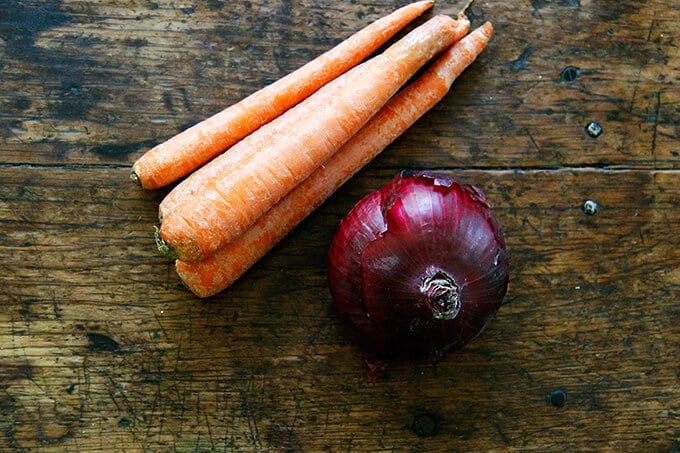
Pour brine over top. Let cool briefly (or to room temperature), then stash in the fridge.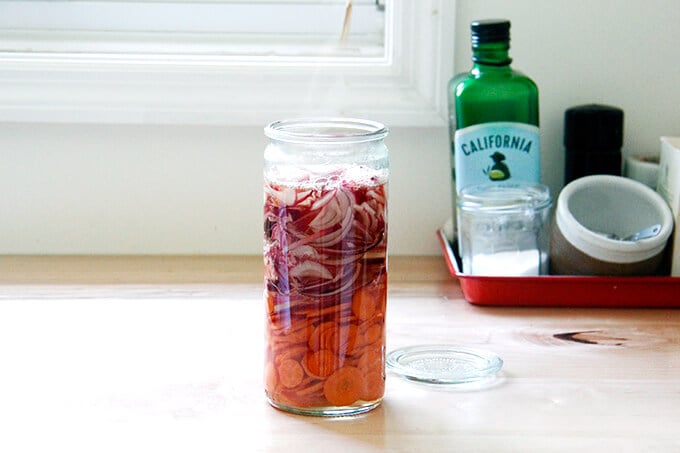
2. While store-bought pickles are perfectly fine, learning how to make your own is enjoyable and incredibly simple, just like making aioli.
Slice them thinly: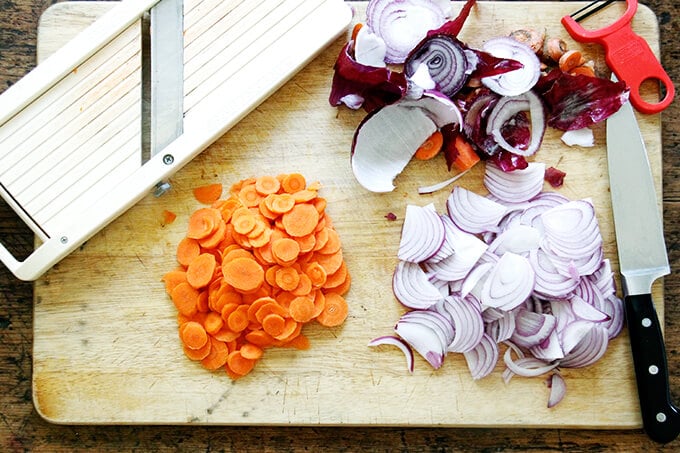
How to Pickle ANYTHING! Quick Pickling Tutorial.
FAQ
What is the 321 pickle rule?
Can I add sugar to pickling vinegar?
What is the ratio of liquid to pickles?
Can you pickle with 4 percent vinegar?
What is a good vinegar to water ratio for Pickles?
The perfect ratio will depend on your personal taste preferences and the type of pickles you’re making. However, a general rule of thumb is to use equal parts vinegar and water, which results in a 1:1 ratio. If you prefer a less tangy pickle, you can adjust the ratio to use more water and less vinegar.
How much pickle juice should one have per day?
Pickle juice has a lot of vinegar and sodium, so it should be used sparingly. There is no recommended amount of pickle juice you should drink each day.
What vinegar should I use for Pickles?
Blanch: green beans (optional, but helps preserve their color) For quick pickles, a basic brine is equal parts vinegar and water, but you can adjust the ratio to your preference. Any basic vinegar is game — white vinegar, apple cider, white wine, and rice vinegar all work well. You can use these vinegars alone or in combination.
Can you add sugar to pickle vinegar & water?
Note: The above ingredient list is just a basic guideline, and you can adjust the ratio and season to your liking. Sugar Notes: However, if you prefer a slightly sweeter pickle, you can add 1-2 tablespoons of sugar to the vinegar and water mixture.
